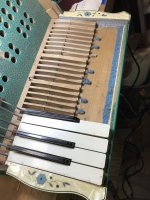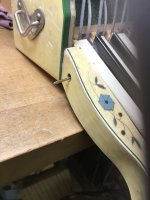32251
Active member
Needed to remove the keys. End of the axle shaft is broken off. I have done a few of these and using a different technique…..depending on the way the key and keybed is made. This is a little Hohner 12 bass unit. The key sits completely in a wooden channel. If over the life of the instrument the key channel warps even a very small amount, the key will not function and you will need to remove and sand the key sides to fit again. When the axle is frozen then you have to be invasive. Every 5 keys or so depending on how bound up the shaft is, remove a white key top…easy with some heat….and take a very thin hacksaw blade and cut the axle on both sides of the key. You will only remove a very tiny amount of wood on the key/keybed. There is plenty more wood mating surface to keep the key inline. Then take a long rod the same diameter as the shaft and drive the old axle in towards the vacated key slot and snip with wire cutters many times till you get that section of axel out. Repeat till you are at the last keys. Use a 1/4” Forster bit and drill a nice clean hole in the opposite side of the keyboard frame. Easy to put a nice celluloid plug in later. Then use a little smaller drill to hit the end of the old axle. Then tap the rest of the axle out as I have pictured. Axle shafts can be so frozen in place after decades. The wood is shrinking around the axle all this time. When the shaft goes through every key and all the key bed sides…..it can become locked in place. There are different key/keybed relationships depending on the manufacturer. Take your time. You will be able to get it all out….a piece at a time. Replace with a new shaft.


